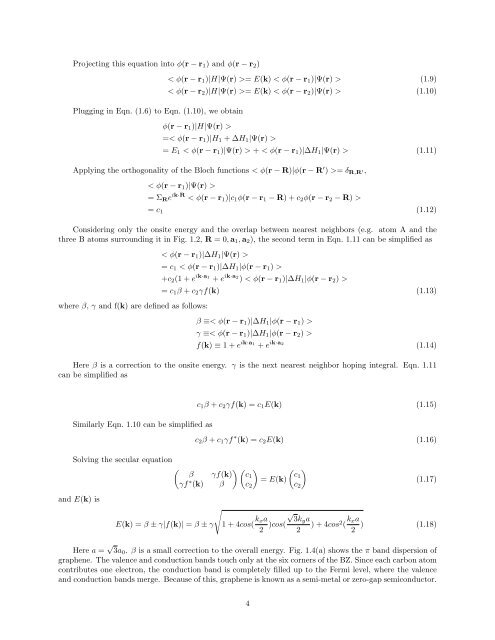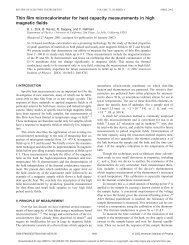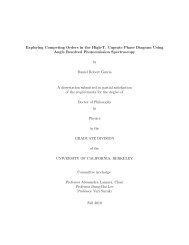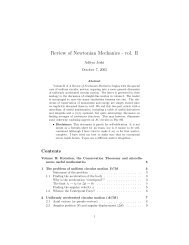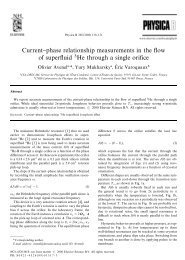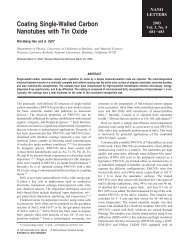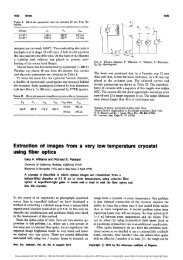Dirac Fermions in Graphene and Graphiteâa view from angle ...
Dirac Fermions in Graphene and Graphiteâa view from angle ...
Dirac Fermions in Graphene and Graphiteâa view from angle ...
Create successful ePaper yourself
Turn your PDF publications into a flip-book with our unique Google optimized e-Paper software.
Project<strong>in</strong>g this equation <strong>in</strong>to φ(r − r 1 ) <strong>and</strong> φ(r − r 2 )<br />
Plugg<strong>in</strong>g <strong>in</strong> Eqn. (1.6) to Eqn. (1.10), we obta<strong>in</strong><br />
< φ(r − r 1 )|H|Ψ(r) >= E(k) < φ(r − r 1 )|Ψ(r) > (1.9)<br />
< φ(r − r 2 )|H|Ψ(r) >= E(k) < φ(r − r 2 )|Ψ(r) > (1.10)<br />
φ(r − r 1 )|H|Ψ(r) ><br />
=< φ(r − r 1 )|H 1 + ∆H 1 |Ψ(r) ><br />
= E 1 < φ(r − r 1 )|Ψ(r) > + < φ(r − r 1 )|∆H 1 |Ψ(r) > (1.11)<br />
Apply<strong>in</strong>g the orthogonality of the Bloch functions < φ(r − R)|φ(r − R ′ ) >= δ R,R ′,<br />
< φ(r − r 1 )|Ψ(r) ><br />
= Σ R e ik·R < φ(r − r 1 )|c 1 φ(r − r 1 − R) + c 2 φ(r − r 2 − R) ><br />
= c 1 (1.12)<br />
Consider<strong>in</strong>g only the onsite energy <strong>and</strong> the overlap between nearest neighbors (e.g. atom A <strong>and</strong> the<br />
three B atoms surround<strong>in</strong>g it <strong>in</strong> Fig. 1.2, R = 0, a 1 , a 2 ), the second term <strong>in</strong> Eqn. 1.11 can be simplified as<br />
< φ(r − r 1 )|∆H 1 |Ψ(r) ><br />
where β, γ <strong>and</strong> f(k) are def<strong>in</strong>ed as follows:<br />
= c 1 < φ(r − r 1 )|∆H 1 |φ(r − r 1 ) ><br />
+c 2 (1 + e ik·a1 + e ik·a2 ) < φ(r − r 1 )|∆H 1 |φ(r − r 2 ) ><br />
= c 1 β + c 2 γf(k) (1.13)<br />
β ≡< φ(r − r 1 )|∆H 1 |φ(r − r 1 ) ><br />
γ ≡< φ(r − r 1 )|∆H 1 |φ(r − r 2 ) ><br />
f(k) ≡ 1 + e ik·a1 + e ik·a2 (1.14)<br />
Here β is a correction to the onsite energy. γ is the next nearest neighbor hop<strong>in</strong>g <strong>in</strong>tegral. Eqn. 1.11<br />
can be simplified as<br />
Similarly Eqn. 1.10 can be simplified as<br />
Solv<strong>in</strong>g the secular equation<br />
( ) ( )<br />
β γf(k) c1<br />
γf ∗ (k) β c 2<br />
<strong>and</strong> E(k) is<br />
E(k) = β ± γ|f(k)| = β ± γ<br />
c 1 β + c 2 γf(k) = c 1 E(k) (1.15)<br />
c 2 β + c 1 γf ∗ (k) = c 2 E(k) (1.16)<br />
√<br />
( )<br />
c1<br />
= E(k)<br />
c 2<br />
(1.17)<br />
1 + 4cos( k √<br />
xa<br />
2 )cos( 3ky a<br />
) + 4cos<br />
2<br />
2 ( k xa<br />
2 ) (1.18)<br />
Here a = √ 3a 0 . β is a small correction to the overall energy. Fig. 1.4(a) shows the π b<strong>and</strong> dispersion of<br />
graphene. The valence <strong>and</strong> conduction b<strong>and</strong>s touch only at the six corners of the BZ. S<strong>in</strong>ce each carbon atom<br />
contributes one electron, the conduction b<strong>and</strong> is completely filled up to the Fermi level, where the valence<br />
<strong>and</strong> conduction b<strong>and</strong>s merge. Because of this, graphene is known as a semi-metal or zero-gap semiconductor.<br />
4


